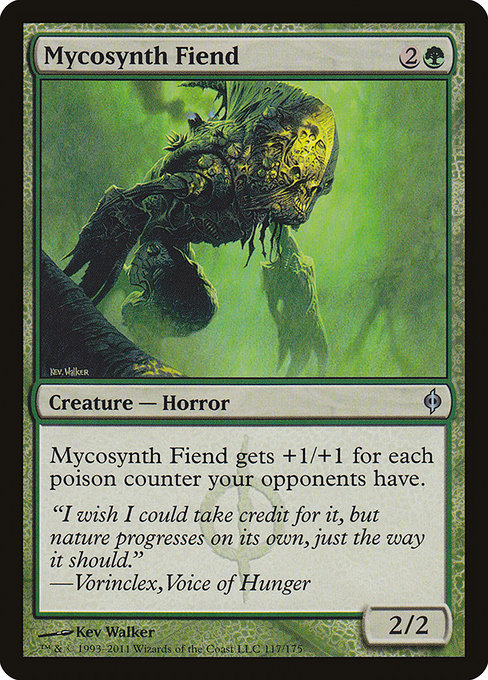
Image courtesy of Scryfall.com
Balancing Randomness and Player Control in MTG: The Mycosynth Fiend Dynamic
In a world where every draw can flip the game, card design often tries to thread the needle between chaos and craftsmanship. Mycosynth Fiend, a green Phyrexian Horror from New Phyrexia, is a perfect case study in how a simple line of text can tilt the balance towards calculated tempo rather than pure luck. This 3-mana creature (2G) starts as a modest 2/2, yet its true power blooms with every poison counter your opponents carry. The flavor here isn’t just about raw stats; it’s about the dance between risk and control, chance and choice 🧙♂️🔥.
New Phyrexia gave us a world where corruption is systemic, and Mycosynth Fiend embodies that ethos. The card’s ability — "This creature gets +1/+1 for each poison counter your opponents have" — scales instantly when your opponents start marching toward the 10-count threshold. In multiplayer Commander, that can become a looming threat that punishes hesitation: you wait to let poison counters accumulate, you count the counters carefully, and you deploy Fiend to exploit that growth. The end result is a living clock on the battlefield, ticking toward a bigger threat as players push their own agendas 💎⚔️.
“I wish I could take credit for it, but nature progresses on its own, just the way it should.” — Vorinclex, Voice of Hunger
The flavor text anchors the mechanical reality: Fiend doesn’t just strike; it benefits from the stagnation and decay that poison counters symbolize in phyrexian philosophy. That synergy is where player agency truly shines. Rather than roll the dice on answers you draw, you’re shaping the game state through how you pressure opponents to accumulate counters, and how you protect and accelerate your own leverage. The card rewards patient planning: ramp into 3-mana threats, protect your investment with green's resilience, and lean on proliferate effects from other cards to tilt the counters in your favor 🧙♂️🎲.
Strategies that balance chaos with control
- Seed a slow build with ramp: In green, you’re used to accelerating your mana. Getting Fiend onto the battlefield early gives you a reliable lever for the late-game swing. If you can dodge wraths and spot removal, you’ll watch Fiend grow as opponents chase their own goals.
- Encourage poison-counter tempo: Use spells and creatures that deal non-lethal damage or directly place poison counters on opponents. The more counters there are, the bigger Fiend becomes. Pair this with proliferate to push those counters even higher over subsequent turns.
- Protect the engine: Fiend loves to eat combat damage, but it’s not invincible. Green’s usual suite of removal protection, or sideboard tech in commander games, helps keep your threat online while you assemble a board state that prints inevitability.
- Plan the win condition beyond Fiend: While the stacks of +1/+1 counters can bury an opponent under a progressive tide, don’t neglect alternate lines: those same green acceleration engines can pivot into overwhelming board presence or artifact synergies that pressure life totals in addition to poison counters.
- Lean into Proliferate: Cards that proliferate naturally amplify Fiend’s buff as the poison-counter landscape shifts. This is a natural synergy in a Four- or Five-Color environment where tax and ramp collide with resilient threats.
As designers and players, we crave that sweet spot where randomness yields to purposeful play. Magic’s modular design—mana curves, card draw, removal—gives us a spectrum. Mycosynth Fiend sits on the green side of the scale, rewarding resource-rich strategies that enable you to stabilize and then pressure. It’s not a one-card win condition; it’s a catalyst that rewards you for reading the table’s chemistry and nudging counters in the right direction. The thrill isn’t just in landing a big hit; it’s in steering a game where every counter on the battlefield is a tiny, deliberate choice 🧠🎨.
Collectors will appreciate the card’s New Phyrexia lineage and Kev Walker’s distinctive art, a reminder that phyrexian corruption can look as glossy as a gleaming engine and as brutal as a blade. Uncommon in rarity, it’s the kind of piece that can crop up in trade binders and deck boxes across EDH tables, silently remodeling what “threat density” feels like in a green-heavy throne room. And while its price tag might be modest (as seen on market trackers), its potential to alter the late-game conversation remains surprisingly impactful, especially when you pair it with proliferate or other poison-counter shenanigans 🧩💎.
In day-to-day play, the most satisfying balance often comes from leaning into both randomness and control. Shuffle your plans, value your topdecks, and remember that the best moments come when you’ve nudged the table toward a path where your synergy with Fiend yields a path to victory that doesn’t require you to bet the farm on a single roll of the dice. It’s the same kind of joy you feel when that perfect long-term plan comes together—quiet, methodical, and a little bit sneaky. And yes, you’ll probably need a comfortable mouse pad for the long grind of deck-building and tuning sessions 🧙♂️🎨.
Foot-Shaped Ergonomic Memory Foam Mouse Pad with Wrist RestImage courtesy of Scryfall.com
More from our network
- https://blog.digital-vault.xyz/blog/post/shambling-shell-mtg-art-through-the-decades/
- https://blog.digital-vault.xyz/blog/post/countering-cast-down-best-answers-and-card-choices/
- https://blog.digital-vault.xyz/blog/post/collectors-vault-expanding-plane-culture-through-artifacts/
- https://transparent-paper.shop/blog/post/hot-b-star-bp-rp-color-index-signals-distant-brilliance/
- https://blog.digital-vault.xyz/blog/post/popular-syndicate-heavy-edh-commander-decks-revealed/